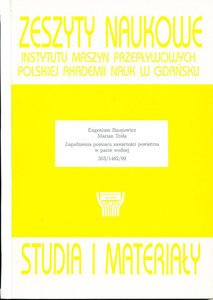Zeszyty Naukowe
Zagadnienia pomiaru zawartości powietrza w parze wodnej
503/1462/99.Praca dotyczy pomiaru zawartości powietrza w mieszaninie para-powietrze dla urządzeń technicznych typu urządzenia energetyczne, skraplacze, smoczki parowe itp. w stosunkowo dużym zakresie ciśnienia i temperatury. Celem pracy było opracowanie metody pomiaru zawartości powietrza w parzę wodnej oraz zbudowanie prototypowego czujnika do pomiaru tej wielkości ftzycznej. Idea pomysłu opiera się na znajomości procesu wymiany ciepła między chłodzoną powierzchnią ciała stałego a mieszaniną dwuskładnikową para-powietrze. Jeżeli mieszanina ta jest w stanie przegrzania to intensywność procesu jest stosunkowo mała i zależna od ruchu konwekcyjnego pary w stanie nasycenia występuje wykraplanie pary z mieszaniny, co powoduje gwałtowny wzrost intensywności wymiany ciepła. Cel pracy zrealizowano głównie przez prace teoretyczne nad wykraplaniem pary z mieszaniny, badanie konwekcyjnej wymiany ciepła wewnątrz czujnika, badania eksperymentalne skraplania się pary na czujniku, badania struktury spływu fazy ciekłej z czujnika budowę trzech prototypowa następnie przetestowanie różnych konfiguracji geometrycznych czujnika.
In the project a problem of measuring of an air contribution in steam-air mixture in relatively wide range of pressure and temperature has been considered, which is important for technical applications in such apparatures as condensers, steam driven ejectors, etc. The aim of the project was to develop a method of measuring the air content in steam as well as a prototype sensor for measuring of this physical quantity. An idea was based on the knowledge of heat transfer process between the cooled surface of solid body and two-component mixture steam-air. Intensity of this process is not very high if the mixture is superheated and it is governed then by convection of steam. In a saturation state condensation of steam occurs which leads to rapid augmentation of heat transfer. The aim of the project has been reached mainly due to theoretical works on steam condensation from the mixture, investigation of convective heat transfer inside the sensor, experimental investigation of steam condensation on the sensor, investigation of a structure of flow of water out from the sensor, developing of three prototypes and then testing of different geometrical configurations of the sensor.






















